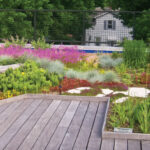Sustainable landscaping is a growing trend that focuses on creating outdoor spaces that are both beautiful and environmentally friendly. From conserving water to reducing chemical usage, there are a variety of ways in which sustainable landscaping practices can benefit the environment.
One of the key principles of sustainable landscaping is water conservation. This can be achieved through techniques such as xeriscaping, which uses drought-tolerant plants and efficient irrigation systems to reduce water usage. By incorporating native plants that are well-adapted to local climate conditions, homeowners can create a vibrant landscape that requires minimal watering.
In addition to water conservation, sustainable landscaping also aims to minimize the use of chemicals and pesticides. Instead of relying on synthetic fertilizers and herbicides, sustainable landscaping practices focus on organic options that are better for the environment. Composting organic matter, using natural pest control methods, and choosing native plants that are resistant to pests and diseases are all ways to reduce the need for harmful chemicals.
Another aspect of sustainable landscaping is soil health. Healthy soil is essential for supporting plant growth and biodiversity. By practicing techniques such as mulching, composting, and avoiding soil compaction, homeowners can improve soil quality and promote a thriving ecosystem in their gardens.
Sustainable landscaping also emphasizes the importance of biodiversity. By incorporating a variety of plants, trees, and shrubs, homeowners can create a habitat that attracts pollinators, birds, and other beneficial wildlife. This not only enhances the beauty of the landscape but also contributes to a healthier ecosystem.
Overall, sustainable landscaping is a holistic approach to designing and maintaining outdoor spaces that is both aesthetically pleasing and environmentally friendly. By implementing practices that conserve water, reduce chemical usage, and promote biodiversity, homeowners can create a sustainable landscape that benefits both the environment and their own well-being.
















